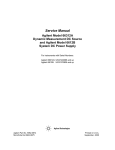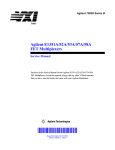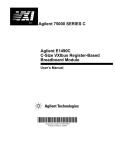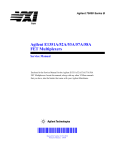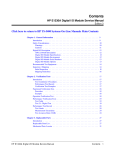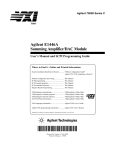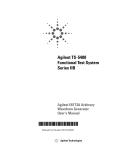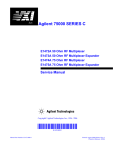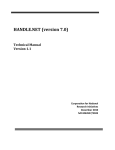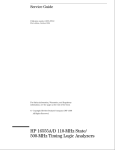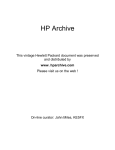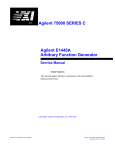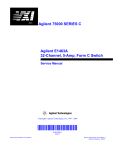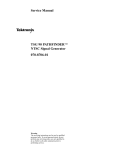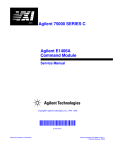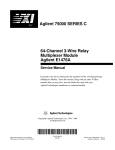Download E1446A Summing Amplifier/DAC Module Service Manual
Transcript
Agilent 75000 SERIES C Agilent E1446A Summing Amplifier/DAC Module Service Manual Copyright© Agilent Technologies, Inc., 1993 - 2006 *E1446-90010* E1446-90010 E0706 Manual Part Number: E1446-90010 Printed: July 2006 Edition 2 Rev 2 Printed in Malaysia E0706 Certification Agilent Technologies certifies that this product met its published specifications at the time of shipment from the factory. Agilent Technologies further certifies that its calibration measurements are traceable to the United States National Institute of Standards and Technology (formerly National Bureau of Standards), to the extent allowed by that organization’s calibration facility, and to the calibration facilities of other International Standards Organization members. Warranty This Agilent Technologies product is warranted against defects in materials and workmanship for a period of one (1) year from date of shipment. Duration and conditions of warranty for this product may be superseded when the product is integrated into (becomes a part of) other Agilent products. During the warranty period, Agilent Technologies will, at its option, either repair or replace products which prove to be defective. For warranty service or repair, this product must be returned to a service facility designated by Agilent Technologies. Buyer shall prepay shipping charges to Agilent and Agilent shall pay shipping charges to return the product to Buyer. However, Buyer shall pay all shipping charges, duties, and taxes for products returned to Agilent from another country. Agilent warrants that its software and firmware designated by Agilent for use with a product will execute its programming instructions when properly installed on that product. Agilent does not warrant that the operation of the product, or software, or firmware will be uninterrupted or error free. Limitation Of Warranty The foregoing warranty shall not apply to defects resulting from improper or inadequate maintenance by Buyer, Buyer-supplied products or interfacing, unauthorized modification or misuse, operation outside of the environmental specifications for the product, or improper site preparation or maintenance. The design and implementation of any circuit on this product is the sole responsibility of the Buyer. Agilent does not warrant the Buyer’s circuitry or malfunctions of Agilent products that result from the Buyer’s circuitry. In addition, Agilent does not warrant any damage that occurs as a result of the Buyer’s circuit or any defects that result from Buyer-supplied products. NO OTHER WARRANTY IS EXPRESSED OR IMPLIED. Agilent SPECIFICALLY DISCLAIMS THE IMPLIED WARRANTIES OF MERCHANTABILITY AND FITNESS FOR A PARTICULAR PURPOSE. Exclusive Remedies THE REMEDIES PROVIDED HEREIN ARE BUYER’S SOLE AND EXCLUSIVE REMEDIES. Agilent SHALL NOT BE LIABLE FOR ANY DIRECT, INDIRECT, SPECIAL, INCIDENTAL, OR CONSEQUENTIAL DAMAGES, WHETHER BASED ON CONTRACT, TORT, OR ANY OTHER LEGAL THEORY. Notice The information contained in this document is subject to change without notice. Agilent Technologies MAKES NO WARRANTY OF ANY KIND WITH REGARD TO THIS MATERIAL, INCLUDING, BUT NOT LIMITED TO, THE IMPLIED WARRANTIES OF MERCHANTABILITY AND FITNESS FOR A PARTICULAR PURPOSE. Agilent shall not be liable for errors contained herein or for incidental or consequential damages in connection with the furnishing, performance or use of this material. This document contains proprietary information which is protected by copyright. All rights are reserved. No part of this document may be photocopied, reproduced, or translated to another language without the prior written consent of Agilent Technologies, Inc. Agilent assumes no responsibility for the use or reliability of its software on equipment that is not furnished by Agilent. U.S. Government Restricted Rights The Software and Documentation have been developed entirely at private expense. They are delivered and licensed as "commercial computer software" as defined in DFARS 252.227- 7013 (Oct 1988), DFARS 252.211-7015 (May 1991) or DFARS 252.227-7014 (Jun 1995), as a "commercial item" as defined in FAR 2.101(a), or as "Restricted computer software" as defined in FAR 52.227-19 (Jun 1987)(or any equivalent agency regulation or contract clause), whichever is applicable. You have only those rights provided for such Software and Documentation by the applicable FAR or DFARS clause or the Agilent standard software agreement for the product involved. Agilent E1446A Summing Amplifier/DAC Module Service Manual Edition 1 Rev 2 Copyright © 1993-2006 Agilent Technologies, Inc. All Rights Reserved. i Printing History The Printing History shown below lists all Editions and Updates of this manual and the printing date(s). The first printing of the manual is Edition 1. The Edition number increments by 1 whenever the manual is revised. Updates, which are issued between Editions, contain replacement pages to correct the current Edition of the manual. Updates are numbered sequentially starting with Update 1. When a new Edition is created, it contains all the Update information for the previous Edition. Each new Edition or Update also includes a revised copy of this printing history page. Many product updates or revisions do not require manual changes and, conversely, manual corrections may be done without accompanying product changes. Therefore, do not expect a one-to-one correspondence between product updates and manual updates. Edition 1 (Part Number E1446-90010). . . . . . . . . . . . . . . . . . . . . . January 1993 Edition 1 Rev 2 (Part Number E1446-90010) . . . . . . . . . . . . . . . . . . . July 2006 Safety Symbols Instruction manual symbol affixed to product. Indicates that the user must refer to the manual for specific WARNING or CAUTION information to avoid personal injury or damage to the product. Alternating current (AC). Direct current (DC). Indicates hazardous voltages. Indicates the field wiring terminal that must be connected to earth ground before operating the equipment—protects against electrical shock in case of fault. or WARNING Frame or chassis ground terminal—typically connects to the equipment’s metal frame. CAUTION Calls attention to a procedure, practice, or condition that could cause bodily injury or death. Calls attention to a procedure, practice, or condition that could possibly cause damage to equipment or permanent loss of data. WARNINGS The following general safety precautions must be observed during all phases of operation, service, and repair of this product. Failure to comply with these precautions or with specific warnings elsewhere in this manual violates safety standards of design, manufacture, and intended use of the product. Agilent Technologies assumes no liability for the customer’s failure to comply with these requirements. Ground the equipment: For Safety Class 1 equipment (equipment having a protective earth terminal), an uninterruptible safety earth ground must be provided from the mains power source to the product input wiring terminals or supplied power cable. DO NOT operate the product in an explosive atmosphere or in the presence of flammable gases or fumes. For continued protection against fire, replace the line fuse(s) only with fuse(s) of the same voltage and current rating and type. DO NOT use repaired fuses or short-circuited fuse holders. Keep away from live circuits: Operating personnel must not remove equipment covers or shields. Procedures involving the removal of covers or shields are for use by service-trained personnel only. Under certain conditions, dangerous voltages may exist even with the equipment switched off. To avoid dangerous electrical shock, DO NOT perform procedures involving cover or shield removal unless you are qualified to do so. DO NOT operate damaged equipment: Whenever it is possible that the safety protection features built into this product have been impaired, either through physical damage, excessive moisture, or any other reason, REMOVE POWER and do not use the product until safe operation can be verified by service-trained personnel. If necessary, return the product to an Agilent Technologies Sales and Service Office for service and repair to ensure that safety features are maintained. DO NOT service or adjust alone: Do not attempt internal service or adjustment unless another person, capable of rendering first aid and resuscitation, is present. DO NOT substitute parts or modify equipment: Because of the danger of introducing additional hazards, do not install substitute parts or perform any unauthorized modification to the product. Return the product to an Agilent Technologies Sales and Service Office for service and repair to ensure that safety features are maintained. ii DECLARATION OF CONFORMITY According to ISO/IEC Guide 22 and CEN/CENELEC EN 45014 Manufacturer’s Name: Manufacturer’s Address: Agilent Technologies, Incorporated th 815 – 14 St. SW Loveland, Colorado 80537 USA Declares, that the product Product Name: Model Number: Product Options: Summing Amplifier/DAC E1446A This declaration covers all options of the above product(s). Conforms with the following European Directives: The product herewith complies with the requirements of the Low Voltage Directive 73/23/EEC and the EMC Directive 89/336/EEC (including 93/68/EEC) and carries the CE Marking accordingly. Conforms with the following product standards: EMC Safety Standard Limit CISPR 11:1990 / EN 55011:1991 IEC 801-2 :1991 / EN50082-1 : 1992 IEC 801-3 :1984 / EN50082-1 : 1992 IEC 801-4 :1988 / EN50082-1 : 1992 Group 1 Class A 4kV CD, 8kV AD 3 V/m 0.5kV signal lines, 1kV power lines The produt was tested in a typical configuration with Agilent Technologies or Hewlett-Packard Company test systems IEC 1010-1:1990+A2:1996 / EN 61010-1:1993 Canada: CSA C22.2 No. 1010.1:1992 UL 3111-1 3 May 2001 Date Ray Corson Product Regulations Program Manager For further information, please contact your local Agilent Technologies sales office, agent or distributor. Authorized EU-representative: Agilent Technologies Deutschland GmbH, Herrenberger Straβe 130, D 71034 Böblingen, Germany iii Agilent 75000 Series C Service Documentation Suggested Sequence to Use Manuals Manual Descriptions Title Description Series C Installation and Getting Started Guide Step-by-step instructions for all aspects of plug-in module, mainframe, and command module installation. Also contains introductory programming information and examples. Mainframe User’s Manual Information to prepare the mainframe and to install plug-in modules. Command Module User’s Programming information for the command module and general programming information for instruments installed in the mainframe. Manual Command Module Service Manual Command module service information. Includes information and procedures for functional verification, operation verification, performance verification, troubleshooting, and repair. Plug-In Module User’s Manuals Plug-in module programming and configuration information. Contains programming examples and SCPI command reference for the module. Plug-In Module Service Manuals Plug-in module service information. Depending on the module, includes information and procedures for functional verification, operation verification, performance verification, adjustment, troubleshooting, and repair. iv What’s in this Manual Manual Overview This manual shows how to service the Agilent E1446A Summing Amplifier/DAC. See the Agilent E1446A User’s Manual for additional information on installing, configuring, and operating the instrument. Consult the appropriate mainframe manual for information on configuring and operating the mainframe. Manual Content Chap Title Content 1 General Information Lists basic instrument descriptions, tools and test equipment required for service, and procedures to inspect and ship the instrument. 2 Verification Tests Describes functional verification, operation verification, and performance verification tests for the instrument. 3 Replaceable Parts Lists part numbers of replaceable parts for the instrument. Also includes information to order spare parts and to exchange/replace instruments. 4 Service Procedures to aid in fault isolation and repair of the instrument. v vi Contents Chapter 1 - General Information Introduction . . . . . . . . . . Safety Considerations . . . . . Warnings and Cautions . . Inspection/Shipping . . . . . . Initial Inspection . . . . . . Shipping Guidelines . . . . Environment . . . . . . . . . . Amplifier Description . . . . . Amplifier Specifications . . Amplifier Serial Numbers . Recommended Test Equipment . . . . . . . . . . . . . . . . . . . . . . . . . . . . . . . . . . . . . . . . . . . . . . . . . . . . . . . . . . . . . . . . . . . . . . . . . . . . . . . . . . . . . . . . . . . . . . . . . . . . . . . . . . . . . . . . . . . . . . . . . . . . . . . . . . . . . . . . . . . . . . . . . . . . . . . . . . . . . . . . . . . . . . . . . . . . . . . . . . . . . . . . . . . . . . . . . . . . . . . . . . . . . . . . . . . . . . . . . . . . . . . . . . . . . . . . . . . . . . . . . . . . . . . . . . . . . . . . . . . . . . . 1-1 1-2 1-2 1-4 1-4 1-5 1-6 1-6 1-6 1-6 1-7 Introduction . . . . . . . . . . . . . . . . . Test Conditions/Procedures . . . . . . . . . Performance Test Record . . . . . . . . . . Verification Test Examples . . . . . . . . . Using an Agilent E1445A as the Commander Functional Verification . . . . . . . . . . . . . . Operation Verification . . . . . . . . . . . . . . Performance Verification . . . . . . . . . . . . Test 2-1: Input Attenuator Test . . . . . . . Test 2-2: Output Attenuator Test . . . . . . Test 2-3: Low-level Outputs Test . . . . . . Test 2-4: Main Output Test . . . . . . . . . Test 2-5: Offset DAC Test . . . . . . . . . . Test 2-6: Bandwidth Test . . . . . . . . . . Performance Test Record . . . . . . . . . . . . Amplifier Test Limits . . . . . . . . . . . . . Measurement Uncertainty . . . . . . . . . . Test Accuracy Ratio (TAR) . . . . . . . . . . . . . . . . . . . . . . . . . . . . . . . . . . . . . . . . . . . . . . . . . . . . . . . . . . . . . . . . . . . . . . . . . . . . . . . . . . . . . . . . . . . . . . . . . . . . . . . . . . . . . . . . . . . . . . . . . . . . . . . . . . . . . . . . . . . . . . . . . . . . . . . . . . . . . . . . . . . . . . . . . . . . . . . . . . . . . . . . . . . . . . . . . . . . . . . . . . . . . . . . . . . . . . . . . . . . . . . . . . . . . . . . . . . . . . . . . . . . . . . . . . . . . . . . . . . . . . . . . . . . . . . . . . . . . . . 2-1 2-1 2-1 2-2 2-2 2-3 2-4 2-4 2-5 2-9 2-13 2-16 2-19 2-22 2-26 2-26 2-26 2-26 Chapter 2 - Verification Tests Chapter 3 - Replaceable Parts Introduction . . . . . . . Exchange Assemblies Ordering Information Replaceable Parts List . . . . . . . . . . . . . . . . . . . . . . . . . . . . . . . . . . . . . . . . . . . . . . . . . . . . . . . . . . . . . . . . . . . . . . . . . . . . . . . . . . . . . . . . . . . . . . . . . . . . . . . . . . . . . . 3-1 3-1 3-1 3-1 Introduction . . . . . . . . . . . . . Equipment Required . . . . . . . Service Aids . . . . . . . . . . . Repair Strategy . . . . . . . . . . Troubleshooting Techniques . . . Identifying the Problem . . . . . Testing the Assembly . . . . . . Disassembly . . . . . . . . . . . Repair/Maintenance Guidelines . . . ESD Precautions . . . . . . . . Soldering Printed Circuit Boards Post-Repair Safety Checks . . . . . . . . . . . . . . . . . . . . . . . . . . . . . . . . . . . . . . . . . . . . . . . . . . . . . . . . . . . . . . . . . . . . . . . . . . . . . . . . . . . . . . . . . . . . . . . . . . . . . . . . . . . . . . . . . . . . . . . . . . . . . . . . . . . . . . . . . . . . . . . . . . . . . . . . . . . . . . . . . . . . . . . . . . . . . . . . . . . . . . . . . . . . . . . . . . . . . . . . . . . . . . . . . . . . . . . . . . . . . . . . . . . . . . . . . . . . . . . . . . . . . . . . . . . . . . . 4-1 4-1 4-1 4-1 4-2 4-2 4-2 4-3 4-4 4-4 4-4 4-4 Chapter 4 - Service 1 General Information Introduction This manual contains information required to test, troubleshoot, and repair the Agilent E1446A C-Size VXI Summing Amplifier/DAC (amplifier). See the Agilent E1446A User’s Manual for additional information. Figure 1-1 shows the Agilent E1446A. This chapter includes the following sections: • • • • • • Introduction Safety Considerations Inspection/Shipping Environment Amplifier Description Recommended Test Equipment Figure 1-1. Agilent E1446A Summing Amplifier/DAC General Information 1-1 Safety Considerations This product is a Safety Class I instrument that is provided with a protective earth terminal when installed in the mainframe. The mainframe, amplifier, and all related documentation should be reviewed for familiarization with safety markings and instructions before operation or service. Refer to the WARNINGS page (page iii) in this manual for a summary of safety information. Safety information for preventive maintenance, testing, and service follows and is also found throughout this manual. Warnings and Cautions WARNING This section contains WARNINGS which must be followed for your protection and CAUTIONS which must be followed to avoid damage to the equipment when performing instrument maintenance or repair. SERVICE-TRAINED PERSONNEL ONLY. The information in this manual is for service-trained personnel who are familiar with electronic circuitry and are aware of the hazards involved. To avoid personal injury or damage to the instrument, do not perform procedures in this manual or do any servicing unless you are qualified to do so. CHECK MAINFRAME POWER SETTINGS. Before applying power, verify that the mainframe setting matches the line voltage and that the correct fuse is installed. An uninterruptible safety earth ground must be provided from the main power source to the supplied power cord set. GROUNDING REQUIREMENTS. Interruption of the protective (grounding) conductor (inside or outside the mainframe) or disconnecting the protective earth terminal will cause a potential shock hazard that could result in personal injury. (Grounding one conductor of a two-conductor outlet is not sufficient protection.) IMPAIRED PROTECTION. Whenever it is likely that instrument protection has been impaired, the mainframe must be made inoperative and be secured against any unintended operation. 1-2 General Information WARNING REMOVE POWER IF POSSIBLE. Some procedures in this manual may be performed with power supplied to the mainframe while protective covers are removed. Energy available at many points may, if contacted, result in personal injury. (If maintenance can be performed without power applied, the power should be removed.) USING AUTOTRANSFORMERS. If the mainframe is to be energized via an autotransformer (for voltage reduction) make sure the common terminal is connected to neutral (that is, the grounded side of the main’s supply). CAPACITOR VOLTAGES. Capacitors inside the mainframe may remain charged even when the mainframe has been disconnected from its source of supply. USE PROPER FUSES. For continued protection against fire hazard, replace the line fuses only with fuses of the same current rating and type (such as normal blow, time delay, etc.). Do not use repaired fuses or short-circuited fuseholders. CAUTION Static electricity is a major cause of component failure. To prevent damage to the electrical components in the amplifier, observe anti-static techniques whenever working on the amplifier. General Information 1-3 Inspection/ Shipping This section describes initial (incoming) inspection and shipping guidelines for the amplifier. Initial Inspection WARNING Use the steps in Figure 1-2 as guidelines to perform initial inspection of the amplifier. To avoid possible hazardous electrical shock, do not perform electrical tests if there are signs of shipping damage to the shipping container or to the instrument. Notify Agilent and carrier. Notify Agilent Return Module to Agilent Figure 1-2. Initial (Incoming) Inspection Guidelines 1-4 General Information Shipping Guidelines Follow the steps in Figure 1-3 to return the amplifier to a Agilent Technologies Sales and Support Office or Service Center. 1 Prepare the Module • Attach tag to module that identifies - owner - Model Number/Serial Number - Service Required • Place tagged device in anti-static bag 2 Package the Module • Place packaged module in shipping carton* Place 75 to 100 mm (3 to 4 inches) of shockabsorbing shock-absorbing material around the module • Seal the shipping carton securely • Mark the shipping carton FRAGILE 3 Ship the Module to Agilent Technologies • Place address label on shipping carton * * • Send carton to Agilent Technologies * We recommend you use the same shipping materials as those used in factory packaging (available from Agilent Technologies). For other (commercially-available) shipping materials, use a double-wall carton with minimum 2.4 MPa (350 psi) test. Figure 1-3. Packaging/Shipping Guidelines General Information 1-5 Environment The recommended operating environment for the Agilent E1446A amplifier is: Environment Temperature Humidity Operating 0oC to +55oC <65% relative (0oC to +40oC) Storage and Shipment -40oC to +75oC <65% relative (0oC to +40oC) Amplifier Description The Agilent E1446A amplifier is a VXIbus C-size, register-based instrument. The amplifier can operate in a C-size VXIbus mainframe using an Agilent E1405/E1406 Command Module and Standard Commands for Programmable Instruments (SCPI). If the amplifier address is within the Servant Area of an Agilent E1445A Arbitrary Function Generator, then the amplifier can operate without a Command Module. Amplifier Specifications Amplifier specifications are listed in Appendix A of the Agilent E1446A User’s Manual. These specifications are the performance standards or limits against which the instrument may be tested. Amplifier Serial Numbers Figure 1-4 shows Agilent Technologies serial number structure. Amplifiers covered by this manual are identified by a serial number prefix listed on the title page. Agilent Technologies Serial Numbers Figure 1-4. Agilent Technologies Serial Numbers 1-6 General Information Recommended Test Equipment Table 1-1 lists the test equipment recommended for testing and servicing the amplifier. Essential requirements for each piece of test equipment are described in the Requirements column. Table 1-1. Recommended Test Equipment Instrument Requirements Recommended Model Use* Controller, GPIB GPIB compatibility as defined by IEEE Standard 488-1988 and the identical ANSI Standard MC1.1: SH1, AH1, T2, TE0, L2, LE0, SR0, RL0, PP0, DC0, DT0, and C1, 2, 3, 4, 5. HP 9000 Series 300 F,O, P,T Mainframe Compatible with amplifier Agilent E1400B/T or Agilent E1401A F,O, P,T Command Module TTL compatible Trig Out Agilent E1405B or Agilent E1406A F,O, P,T Digital Multimeter DCV Agilent 3458A O,P Function Generator DCV Agilent 3325A/B O,P Spectrum Analyzer Frequency Range: 100 Hz - 40 MHz Tracking Generator: -10 dBm (nominal) Agilent 3585A/B P * F = Functional Verification, O = Operation Verification Tests, P = Performance Verification Tests, T = Troubleshooting General Information 1-7 1-8 General Information 2 Verification Tests Introduction The three levels of test procedures described in this chapter are used to verify that the Agilent E1446A: • is fully functional (Functional Verification) • meets selected testable specifications (Operation Verification) • meets all testable specifications (Performance Verification) WARNING Do not perform any of the following verification tests unless you are a qualified, service-trained technician and have read the WARNINGS and CAUTIONS in Chapter 1. Test Conditions/ Procedures See Table 1-1 for test equipment requirements. You should complete the Performance Verification tests at least once a year. For heavy use or severe operating environments, perform the tests more often. Before performing these tests, allow the amplifier to warm up for at least one hour. The temperature should be between 18oC and 28oC. The verification tests assume that the person performing the tests understands how to operate the mainframe, the amplifier, and specified test equipment. The test procedures do not specify equipment settings for test equipment, except in general terms. It is assumed that a qualified, service-trained technician will select and connect the cables, adapters, and probes required for the test. Performance Test Record The results of each Performance Verification test may be recorded in Table 2-4, Agilent E1446A Performance Test Record. This form can be copied, if desired. Verification Tests 2-1 Verification Test Examples Each verification test procedure includes an example program that performs the test. All example programs assume the following configuration: • • • • • Using an Agilent E1445A as the Commander Controller is an HP 9000 Series 200/300 computer Programming language is BASIC Amplifier address is 70911 (logical address is 88) Amplifier Commander is an Agilent E1405/E1406 DMM is an Agilent 3458A at address 722 The procedures and examples in this chapter assume that the amplifier is configured as a stand-alone instrument. (i.e., it is not a servant of an Agilent E1445A Arbitrary Function Generator). To use an Agilent E1445A as the commander, make sure that the amplifier is placed in the servant area of the E1445A, then send all commmands to the E1445A address (see the Agilent E1446A User’s Manual for more information). The procedures and examples in this chapter can be modified to work with an E1445A as the Commander by changing the following keywords as shown and sending all commands to the E1445A. Agilent E1446A Commands Agilent E1405/E1406 Commander Agilent E1445A Commander INPut[1] :ATTenuation :IMPedance INPut[1] :ATTenuation :IMPedance INPut2 :ATTenuation :IMPedance INPut2 :ATTenuation :IMPedance OUTPut1 :ATTenuation :IMPedance :OVERload? [:STATe] :ACTual? OUTPut2 :ATTenuation :IMPedance :OVERload? [:STATe] :ACTual? OUTPut2 :IMPedance OUTPut3 :IMPedance OUTPut3 :IMPedance OUTPut4 :IMPedance SOURce:VOLTage [:LEVel][:IMMediate]:OFFSet SOURce2:VOLTage [:LEVel][:IMMediate]:OFFSet 2-2 Verification Tests Functional Verification The purpose of this test is to verify communication with the mainframe or command module. No attempt is made to verify that the amplifier is meeting specifications. Functional Verification for the amplifier is accomplished by performing the Self-Test described below. Self-Test Procedure 1. Remove any connections to the amplifier front panel. 2. Reset the amplifier: * RST;* CLS Reset amplifier and clear status registers 3. Execute the amplifier self-test: * TST? Self-test command 4. Read the result. A "0" indicates that the test passed. If a failure occurs, the amplifier returns a "1" and generates an error message that identifies the cause of the failure. Example Program 10 ! 20 30 40 50 60 RE-STORE "SELF_TEST" DIM Result$[255] ASSIGN @Amp TO 70911 ! OUTPUT @Amp;"* RST;* CLS"!Reset amplifier OUTPUT @Amp;"* TST?"!Perform Self-test 70 80 90 ENTER @Amp;Result$ PRINT Result$ END Verification Tests 2-3 Operation Verification Operation Verification is a subset of the Performance Verification tests that follow. For the amplifier, Operation Verification consists of the following tests: • Test 2-3: Low-level Outputs Test • Test 2-4: Main Output Test • Test 2-5: Offset DAC Test Performance Verification The procedures in this section are used to test the amplifier’s electrical performance using the specifications in Appendix A of the Agilent E1446A User’s Manual as the performance standards. These tests are suitable for incoming inspection, troubleshooting, and preventive maintenance. The results of the Performance Verification tests should be recorded in the Performance Test Record (Table 2-4). Performance Verification includes the following tests: Test # 2-1 2-2 2-3 2-4 2-5 2-6 2-4 Verification Tests Test Name Input Attenuation Test Output Attenuation Test Low-Level Outputs Test Main Output Test Offset DAC Test Bandwidth Test Test 2-1: Input Attenuator Test Description Equipment Setup The purpose of this test is to verify that the amplifier meets its specifications for input attenuator accuracy. • Set Source to: DCV • Set DMM to: DCV, autorange • Connect the DMM to the amplifier as shown in Figure 2-1 Figure 2-1. Input Attenuation Test Setup Test Procedure 1. Reset the amplifier: * RST;* CLS Reset amplifier and clear status registers 2. Set the amplifier Input1 attenuation: INP1:ATT 0 3. Connect the Source to Input1 as shown in Figure 2-1. 4. Set the Source to + 0.5 VDC and measure the amplifier output with the DMM. Repeat with the Source set to -0.5 VDC. Average the two readings to get a reference level: Reference Level (V) = Positive Reading (V) − Negative Reading ( V) 2 Verification Tests 2-5 5. Set the amplifier Input1 attenuation to 1 dB: INP1:ATT 1 6. Measure a + 0.5 VDC signal and a -0.5 VDC signal as in step 4. Average the two readings: Averaged Reading (V) = Positive Reading (V) − Negative Reading ( V) 2 7. Calculate the attenuation using the results from steps 4 and 6. Record the result in Table 2-4. æ Averaged Reading ( V) ö ÷ Attenuation (dB) = 20 ⋅ log ç è Reference Level ( V) ø 8. Repeat steps 5 - 7 for the attenuations shown below, changing step 5 as specified: Attenuation Setting (dB) Step 5 Command 2 4 8 16 INP1:ATT 2 INP1:ATT 4 INP1:ATT 8 INP1:ATT 16 9. Set the amplifier Input2 attenuation: INP2:ATT 0 10. Connect the Source to Input2 as shown in Figure 2-1. 11. Repeat steps 4 - 8 for Input2, changing step 5 as shown below. 2-6 Verification Tests Attenuation Setting (dB) Step 5 Command 1 2 4 8 16 INP2:ATT 1 INP2:ATT 2 INP2:ATT 4 INP2:ATT 8 INP2:ATT 16 Example Program 10 ! 20 30 40 RE-STORE "INPUT_ATTN" ! !---------- Set up I/O path ---------ASSIGN @Amp TO 70911 50 60 70 80 90 100 110 120 130 140 150 160 170 180 190 200 210 220 230 240 250 260 270 280 290 300 310 320 330 340 350 360 370 380 400 410 ASSIGN @Dmm TO 722 ! !---------- Initialize variables ---------Vin= .5 ! !---------- Set up DMM ---------DISP "Connect DMM to Diff + Output, then press ’Continue’" PAUSE CLEAR SCREEN OUTPUT @Dmm;"PRESET NORM;DCV;RANGE AUTO" WAIT 1 ! !---------- Set up amplifier ---------OUTPUT @Amp;"* RST;* CLS" !Reset amplifier WAIT .5 ! !---------- Perform test ---------FOR Ch= 1 TO 2 OUTPUT @Amp;"INP"&VAL$(Ch)&":ATT 0" ! DISP "Connect Source to Input"&VAL$(Ch)&", then press ’Continue’" PAUSE DISP ! GOSUB Measure Ref_level= (Pos_rdg-Neg_rdg)/2 ! PRINT TAB(12);"Input "&VAL$(Ch) PRINT PRINT USING "10A,10X,12A";"Atten (dB)","Reading (dB)" PRINT FOR I= 0 TO 4 !Loop through attenuations Attn= 2^ I OUTPUT @Amp;"INP"&VAL$(Ch)&":ATT "&VAL$(Attn) WAIT .5 ! 420 430 GOSUB Measure Ave_rdg= (Pos_rdg-Neg_rdg)/2 Continued on next page Verification Tests 2-7 440 450 460 Result_db= 20* LGT(Ave_rdg/Ref_level) Result_db= PROUND(Result_db,-4) PRINT USING "4X,DD,16X,MDD.4D";Attn,Result_db 470 NEXT I !Next attenuation 480 PRINT 490 PRINT 500 NEXT Ch !Next input 510 ! 520 Quit: ! 530 ASSIGN @Amp TO * 540 ASSIGN @Dmm TO * 550 STOP 560 ! 570 Measure: ! 580 !Measure positive signal 590 DISP "Set Source to "&VAL$(Vin)&" VDC, then press ’Continue’" 600 PAUSE 610 DISP 620 OUTPUT @Dmm;"TRIG SGL" 630 ENTER @Dmm;Pos_rdg 640 ! 650 !Measure negative signal 660 DISP "Set Source to "&VAL$(-Vin)&" VDC, then press ’Continue’" 670 PAUSE 680 DISP 690 OUTPUT @Dmm;"TRIG SGL" 700 ENTER @Dmm;Neg_rdg 710 RETURN 720 ! 730 END 2-8 Verification Tests Test 2-2: Output Attenuator Test Description Equipment Setup The purpose of this test is to verify that the amplifier meets its specifications for output attenuator accuracy. • Set Source to: DCV • Set DMM to: DCV, autorange • Connect the DMM to the amplifier as shown in Figure 2-2 Figure 2-2. Output Attenuation Test Setup Test Procedure 1. Reset the amplifier: * RST;* CLS Reset amplifier and clear status registers 2. Connect the Source to Input1 as shown in Figure 2-2. 3. Set the amplifier output attenuation to 0 dB: OUTP1:ATT 0 Verification Tests 2-9 4. Set the Source to + 0.5 VDC and measure the amplifier output with the DMM. Repeat with the Source set to -0.5 VDC. Average the two readings to get a reference level: Reference Level (V) = Positive Reading (V) − Negative Reading ( V) 2 5. Set the amplifier Output attenuation to 20 dB: OUTP1:ATT 20 6. Measure a + 0.5 VDC signal and a -0.5 VDC signal as in step 4. Average the two readings: Averaged Reading (V) = Positive Reading (V) − Negative Reading ( V) 2 7. Calculate the attenuation using the results from steps 4 and 6. Record the results in Table 2-4: æ Averaged Reading ( V) ö Attenuation (dB) = 20 ⋅ log ç ÷ è Reference Level ( V) ø 8. Connect the Source to Input2 as shown in Figure 2-2. 9. Repeat steps 4 - 7 for Input2. 2-10 Verification Tests Example Program 10 ! 20 30 40 RE-STORE "OUTPUT_ATTN" ! !---------- Set up I/O path ---------ASSIGN @Amp TO 70911 50 60 70 80 90 100 110 120 130 140 150 160 170 180 190 200 210 220 230 240 250 260 270 280 290 300 310 320 330 340 350 360 370 380 390 400 ASSIGN @Dmm TO 722 ! !---------- Initialize variables ---------Vin= .5 ! !---------- Set up DMM ---------DISP "Connect DMM to Main Output, then press ’Continue’" PAUSE CLEAR SCREEN OUTPUT @Dmm;"PRESET NORM;DCV;RANGE AUTO" WAIT 1 ! !---------- Set up amplifier ---------OUTPUT @Amp;"* RST;* CLS" !Reset amplifier WAIT .5 ! !---------- Perform test ---------FOR Ch= 1 TO 2 DISP "Connect Source to Input"&VAL$(Ch)&", then press ’Continue’" PAUSE DISP ! !20 dB attenuator OFF OUTPUT @Amp;"OUTP1:ATT 0" WAIT .5 GOSUB Measure Ref_level= (Pos_rdg-Neg_rdg)/2 ! PRINT TAB(12);"Input "&VAL$(Ch) PRINT ! !20 dB attenuator ON OUTPUT @Amp;"OUTP1:ATT 20" WAIT .5 GOSUB Measure Ave_rdg= (Pos_rdg-Neg_rdg)/2 410 ! Continued on next page Verification Tests 2-11 420 430 440 Result_db= 20* LGT(Ref_level/Ave_rdg) Result_db= PROUND(Result_db,-4) PRINT "Reading (dB) = ";Result_db 450 PRINT 460 PRINT 470 NEXT Ch !Next input 480 ! 490 Quit: ! 500 ASSIGN @Amp TO * 510 ASSIGN @Dmm TO * 520 STOP 530 ! 540 Measure: ! 550 !Measure positive signal 560 DISP "Set Source to "&VAL$(Vin)&" VDC, then press ’Continue’" 570 PAUSE 580 DISP 590 OUTPUT @Dmm;"TRIG SGL" 600 ENTER @Dmm;Pos_rdg 610 ! 620 !Measure negative signal 630 DISP "Set Source to "&VAL$(-Vin)&" VDC, then press ’Continue’" 640 PAUSE 650 DISP 660 OUTPUT @Dmm;"TRIG SGL" 670 ENTER @Dmm;Neg_rdg 680 RETURN 690 ! 700 END 2-12 Verification Tests Test 2-3: Low-level Outputs Test Description Equipment Setup The purpose of this test is to verify that the amplifier meets its accuracy specifications for low-level (differential) outputs. • Set Source to: DCV • Set DMM to: DCV, 10 V range Figure 2-3. Low-level Outputs Test Setup Test Procedure 1. Reset the amplifier: * RST;* CLS Reset amplifier and clear status registers Repeat steps 2-5 for each entry listed in Table 2-1: 2. Connect the DMM to the amplifier output specified in Table 2-1 (see Figure 2-3). 3. Connect the Source to the amplifier input specified in Table 2-1 (see Figure 2-3). 4. Set the Source to the input voltage specified in Table 2-1. 5. Measure the amplifier output with the DMM. Record the results in Table 2-4. Verification Tests 2-13 Table 2-1. Low-level Outputs Test Connect DMM to: Connect Source to: Input Voltage (VDC) Diff+ Diff+ Diff+ Diff+ Input1 Input1 Input1 Input2 0.5 0.75 -0.75 0.5 1.0 1.5 -1.5 1.0 DiffDiffDiffDiff- Input1 Input1 Input1 Input2 0.5 0.75 -0.75 0.5 1.0 1.5 -1.5 1.0 Example Program 10 ! 20 30 40 50 60 70 80 90 100 110 120 130 140 150 160 170 190 200 210 220 RE-STORE "LL_OUT" DIM Nominal(1:4),Input$(1:4)[10] ! !---------- Set up I/O path ---------ASSIGN @Amp TO 70911 ASSIGN @Dmm TO 722 ! !---------- Initialize variables ---------Gain= 2.0 RESTORE Data_nominal READ Nominal(* ) ! RESTORE Data_input READ Input$(* ) ! !---------- Set up DMM and source ---------OUTPUT @Dmm;"PRESET NORM;DCV;RANGE 10" ! !---------- Set up amplifier ---------OUTPUT @Amp;"* RST;* CLS" !Reset amplifier WAIT .5 230 240 250 260 ! !---------- Perform test ---------FOR J= 1 TO 2 IF J= 1 THEN 270 280 290 Output$= "DIFF+ " ELSE Output$= "DIFF-" Continued on next page 2-14 Verification Tests Expected Output (VDC) 300 310 320 END IF ! DISP "Connect DMM to "&Output$&", then press ’Continue’" 330 340 350 360 370 380 390 400 PAUSE DISP PRINT TAB(23);Output$ PRINT PRINT USING "5A,6X,9A,4X,11A,4X,11A";"Input","Input (V)","Nominal (V)","Reading (V)" PRINT FOR I= 1 TO 4 Input_v= Nominal(I)/(Gain* ((-1)^ (Output$= "DIFF-"))) 410 !Test connections 420 IF I= 1 OR I= 4 THEN 430 DISP "Connect Source to "&Input$(I)&", then press ’Continue’" 440 PAUSE 450 END IF 460 DISP 470 GOSUB Measure 480 PRINT USING "6A,6X,MD.3D,8X,MD.3D,9X,MD.5D";Input$(I),Input_v,Nominal(I),Rdg 490 NEXT I 500 PRINT 510 PRINT 520 NEXT J 530 Quit: ! 540 ASSIGN @Amp TO * 550 ASSIGN @Dmm TO * 560 STOP 570 Measure: ! 580 !SET SOURCE 590 DISP "Set Source to "&VAL$(Input_v)&" VDC, then press ’Continue’" 600 PAUSE 610 DISP 620 !Measure output 630 OUTPUT @Dmm;"TRIG SGL" 640 ENTER @Dmm;Rdg 650 Rdg= PROUND(Rdg,-5) 660 RETURN 670 Data_nominal: ! 680 DATA 1.0,1.5,-1.5,1.0 690 Data_input: ! 700 DATA INPUT1,INPUT1,INPUT1,INPUT2 710 END Verification Tests 2-15 Test 2-4: Main Output Test Description Equipment Setup The purpose of this test is to verify that the amplifier meets its accuracy specifications for the main output. • Set Source to: DCV • Set DMM to: DCV, autorange • Connect the DMM to the amplifier as shown in Figure 2-4 Figure 2-4. Main Output Test Setup Test Procedure 1. Reset the amplifier: * RST;* CLS Reset amplifier and clear status registers 2. Connect the Source to the amplifier Input1 as shown in Figure 2-4. 3. Set the Source to + 1 VDC and measure the amplifier output. Record the result in Table 2-4. 4. Set the Source to -1 VDC and measure the amplifier output. Record the result in Table 2-4. 5. Repeat steps 3 and 4 with Source connected to Input2. Record the results in Table 2-4. 2-16 Verification Tests Example Program 10 ! 20 30 40 RE-STORE "MAIN_OUT" DIM Nominal(1:2) ! !---------- Set up I/O path ---------- 50 60 70 80 90 100 110 120 130 140 150 160 170 180 190 200 210 220 230 240 250 260 270 280 290 300 310 320 330 340 350 360 370 ASSIGN @Amp TO 70911 ASSIGN @Dmm TO 722 ! !---------- Initialize variables ---------Gain= 20.0 RESTORE Data_nominal READ Nominal(* ) ! !---------- Set up DMM and Source ---------OUTPUT @Dmm;"PRESET NORM;DCV;RANGE AUTO" WAIT .5 DISP "Connect DMM to Main Output of amplifier, then press ’Continue’" PAUSE CLEAR SCREEN ! !---------- Set up amplifier ---------OUTPUT @Amp;"* RST;* CLS" !Reset amplifier WAIT .5 ! !---------- Perform test ---------FOR Ch= 1 TO 2 DISP "Connect Source to Input"&VAL$(Ch)&", then press ’Continue’" PAUSE DISP ! PRINT TAB(17);"INPUT"&VAL$(Ch) PRINT PRINT USING "9A,5X,11A,4X,11A";"Input (V)","Nominal (V)","Reading (V)" PRINT ! FOR I= 1 TO 2 Input_v= Nominal(I)/Gain ! Continued on next page Verification Tests 2-17 380 390 400 GOSUB Measure PRINT USING "1X,SD.3D,9X,SDD.3D,7X,SDD.5D";Input_v,Nominal(I),Rdg NEXT I 410 PRINT 420 PRINT 430 NEXT Ch 440 ! 450 Quit: ! 460 ASSIGN @Amp TO * 470 ASSIGN @Dmm TO * 480 STOP 490 ! 500 Measure: ! 510 !Set Source 520 DISP "Set Source to "&VAL$(Input_v)&" VDC, then press ’Continue’" 530 PAUSE 540 DISP 550 ! 560 !Measure output 570 OUTPUT @Dmm;"TRIG SGL" 580 ENTER @Dmm;Rdg 590 Rdg= PROUND(Rdg,-5) 600 RETURN 610 ! 620 Data_nominal: ! 630 DATA 20.0,-20.0 640 END 2-18 Verification Tests Test 2-5: Offset DAC Test Description Equipment Setup The purpose of this test is to verify that the amplifier meets its offset DAC accuracy specifications. • Set DMM to: DCV, autorange • Connect the DMM to the amplifier as shown in Figure 2-5 Figure 2-5. Offset DAC Test Setup Test Procedure 1. Reset the amplifier: * RST;* CLS Reset amplifier and clear status registers Repeat steps 2 and 3 for each entry in Table 2-2: 2. Set the amplifier offset voltage: VOLT:OFFS < offset voltage> where < offset voltage> is the value specified in Table 2-2. 3. Measure the amplifier output with the DMM and record the result in Table 2-4. Verification Tests 2-19 NOTE Because the DMM is a high-impedance load, the reading should be equal to twice the amplifier’s offset voltage setting. Table 2-2. Offset DAC Test Points Offset Voltage (VDC) Expected reading (VDC) -10.0 -5.0 0.0 5.0 9.9996 -20.0 -10.0 0.0 10.0 19.9992 Example Program 10 ! 20 30 40 50 60 70 80 90 100 110 120 130 140 150 160 170 RE-STORE "OFFSET_DAC" DIM Nominal(1:5) ! !---------- Set up I/O path ---------ASSIGN @Amp TO 70911 ASSIGN @Dmm TO 722 ! !---------- Initialize variables ---------READ Nominal(* ) ! !---------- Set up DMM ---------OUTPUT @Dmm;"PRESET NORM;DCV;RANGE AUTO" DISP "Connect DMM to Main Output, then press ’Continue’" PAUSE CLEAR SCREEN ! !---------- Set up amplifier ---------- 180 190 200 OUTPUT @Amp;"* RST;* CLS" !Reset amplifier WAIT .5 ! Continued on next page 2-20 Verification Tests 210 !---------- Perform test ---------220 PRINT USING "11A,8X,11A";"Nominal (V)","Reading (V)" 230 PRINT 240 ! 250 FOR I= 1 TO 5 260 Dac_v= (Nominal(I)/2.0) 270 GOSUB Measure 280 Result= PROUND(Rdg,-6) 290 PRINT USING "1X,SDD.4D,11X,SDD.5D";Nominal(I),Result 300 NEXT I 310 ! 320 Quit: ! 330 ASSIGN @Amp TO * 340 ASSIGN @Dmm TO * 350 STOP 360 ! 370 Measure: ! 380 !Measure output 390 OUTPUT @Amp;"VOLT:OFFS "&VAL$(Dac_v) 400 OUTPUT @Dmm;"TRIG SGL" 410 ENTER @Dmm;Rdg 420 RETURN 430 ! 440 Data_nominal: ! 450 DATA -20.0,-10.0,0.0,10.0,19.9992 460 END Verification Tests 2-21 Test 2-6: Bandwidth Test Description Equipment Setup The purpose of this test is to verify that the amplifier meets its bandwidth specifications. • Set Spectrum Analyzer’s tracking generator to -10 dBm (nominal) Figure 2-6. Bandwidth Test Setup Test Procedure 1. Reset the amplifier: * RST;* CLS Reset amplifier and clear status registers Repeat steps 2 - 8 for each entry in Table 2-3: 2. Connect the Spectrum Analyzer tracking generator output to the amplifier input specified in Table 2-3 (see Figure 2-6). 3. Set the Spectrum Analyzer range to the value specified in Table 2-3. 4. Connect the Spectrum Analyzer 50 Ω input to the amplifier output specified in Table 2-3 (see Figure 2-6). 2-22 Verification Tests 5. Set the Spectrum Analyzer as follows: • • • • Resolution bandwidth: 30 Hz Video bandwidth: 100 Hz Sweep mode: Manual Manual frequency: 100 Hz 6. Note the amplitude reading at 100 Hz. This value will be used as the reference level in step 8. 7. Set the Spectrum Analyzer as follows: • Resolution bandwidth: 10 kHz • Video bandwidth: 10 kHz • Sweep mode: Continuous 8. Starting from 100 Hz, move the marker to the right until the amplitude reading is 3 dB below the reference level found in step 6. The amplifier bandwidth is equal to the marker frequency at this point. Record the result in Table 2-4. NOTE If the maximum frequency of the Spectrum Analyzer is reached before the 3 dB frequency, record the result as ’> Fmax’, where Fmax is the maximum frequency of the Spectrum Analyzer. If the Spectrum Analyzer is an Agilent 3585A, for example, the result should be written as ’> 40E6’. Table 2-3. Bandwidth Test Points Connect tracking generator to: Connect Spectrum Analyzer input to: Spectrum Analyzer Range: Input1 Input1 Input1 Input2 Input2 Input2 Main Diff+ DiffMain Diff+ Diff- 15 dB -5 dB -5 dB 15 dB -5 dB -5 dB Verification Tests 2-23 Example Program 10 ! RE-STORE "BANDWIDTH" 20 DIM Output$(1:3)[10] 30 ! 40 50 60 70 80 90 100 110 !---------- Set up I/O paths ---------ASSIGN @Amp TO 70911 ! !---------- Initialize variables ---------Max_freq= 4.0E+ 7 ! RESTORE Data_output READ Output$(* ) 120 130 140 150 160 170 180 190 200 210 220 230 240 250 260 270 280 290 300 310 320 330 340 350 ! !---------- Set up amplifier ---------OUTPUT @Amp;"* RST;* CLS" !Reset amplifier WAIT .5 ! !---------- Perform test ---------DISP "Set Analyzer Tracking Generator to -10 dBm (nominal), then press ’Continue’" PAUSE ! FOR Ch= 1 TO 2 DISP "Connect Analyzer Tracking Generator to INPUT"&VAL$(Ch)&", then press ’Continue’" PAUSE DISP ! FOR I= 1 TO 3 DISP "Connect "&Output$(I)&" to Analyzer 50ohm input, then press ’Continue’" PAUSE DISP ! IF Output$(I)= "MAIN" THEN Range$= "15dBm" ELSE Range$= "-5dBm" END IF 360 370 380 390 ! PRINT "Set up Analyzer:" PRINT PRINT " Range: "&Range$ 400 410 PRINT " PRINT " Resolution BW: 30 Hz" Video BW: 100 Hz" Continued on next page 2-24 Verification Tests 420 430 440 450 460 470 480 490 500 510 520 PRINT " Sweep Mode: Manual" PRINT " Manual Frequency: 100 Hz" INPUT "Enter amplitude at 100 Hz (in dBm):",Ref_level CLEAR SCREEN ! GOSUB Meas_bw PRINT "Bandwidth (Hz) = "&VAL$(Bandwidth) DISP "Press ’Continue’ when ready" PAUSE CLEAR SCREEN NEXT I 530 NEXT Ch 540 ! 550 Quit: ! 560 ASSIGN @Amp TO * 570 STOP 580 ! 590 Meas_bw: ! 600 PRINT "Set up Analyzer:" 610 PRINT 620 PRINT " Resolution BW: 10 kHz" 630 PRINT " Video BW: 10 kHz" 640 PRINT " Sweep Mode: Continuous" 650 DISP "Press ’Continue’ when ready" 660 PAUSE 670 CLEAR SCREEN 680 ! 690 PRINT "INPUT"&VAL$(Ch)&"/"&Output$(I)&" OUTPUT" 700 PRINT 710 PRINT "Reference Level (dBm) = ";Ref_level 720 PRINT 730 DISP "Move marker until amplitude is 3dB below the reference, then press ’Continue’" 740 PAUSE 750 INPUT "Enter marker frequency (in Hz)",Bandwidth 760 RETURN 770 ! 780 Data_output: ! 790 DATA MAIN,DIFF+ ,DIFF800 END Verification Tests 2-25 Performance Test Record Table 2-4, Performance Test Record for the Agilent E1446A Amplifier, is a form you can copy and use to record performance verification test results for the amplifier. Table 2-4 shows amplifier accuracy, measurement uncertainty, and test accuracy ratio (TAR) values. Amplifier Test Limits Test limits are defined using the specifications in Appendix A of the Agilent E1446A User’s Manual. The specifications for Bandwidth are single-sided (i.e., there is a lower limit but no upper limit). In the Performance Test Record, the Maximum column will be blank for the Bandwidth Test. Measurement Uncertainty For the performance verification tests in this manual, the measurement uncertainties are based on the accuracy specifications for the following test equipment: Performance Test Test Equipment 1. Input Attenuation Agilent 3458A 2. Output Attenuation Agilent 3458A 3. Low-Level Outputs Agilent 3325B Agilent 3458A 4. Main Output Agilent 3325B Agilent 3458A 5. Offset DAC Agilent 3458A 6. Bandwidth Agilent 3585A Test Accuracy Ratio (TAR) Test Accuracy Ratio (TAR) for the Agilent E1446A is defined as: Amplifier Accuracy divided by Measurement Uncertainty, i.e., TAR = Maximum − Expected Reading Measurement Uncertainty For single-sided measurements, Test Accuracy Ratio is not defined, so ’NA’ (Not Applicable) will appear in the TAR column. For TARs that exceed 10:1, the entry is ’> 10:1’. 2-26 Verification Tests Table 2-4. Performance Test Record for the Agilent E1446A (Page 1 of 4) Test Facility: Name _________________________________________ Report No. _____________________________________ Address ________________________________________ Date ___________________________________________ City/State _______________________________________ Customer ______________________________________ Phone _________________________________________ Tested by _____________________________________ Model ________________________________________ Ambient temperature __________________________oC Serial No. ______________________________________ Relative humidity _______________________________% Options Line frequency _______________________ Hz (nominal) _______________________________________ Firmware Rev. __________________________________ Special Notes: _____________________________________________________________________________________________________ _____________________________________________________________________________________________________ _____________________________________________________________________________________________________ _____________________________________________________________________________________________________ _____________________________________________________________________________________________________ _____________________________________________________________________________________________________ _____________________________________________________________________________________________________ _____________________________________________________________________________________________________ _____________________________________________________________________________________________________ _____________________________________________________________________________________________________ _____________________________________________________________________________________________________ _____________________________________________________________________________________________________ _____________________________________________________________________________________________________ _____________________________________________________________________________________________________ Verification Tests 2-27 Table 2-4. Performance Test Record for the Agilent E1446A (Page 2 of 4) Model ________________________________ Report No. _______________________________ Date _________________ Test Equipment Used: Description Model No. Trace No. Cal Due Date 1. _________________________________ _______________ _______________ _______________ 2. _________________________________ _______________ _______________ _______________ 3. _________________________________ _______________ _______________ _______________ 4. _________________________________ _______________ _______________ _______________ 5. _________________________________ _______________ _______________ _______________ 6. _________________________________ _______________ _______________ _______________ 7. _________________________________ _______________ _______________ _______________ 8. _________________________________ _______________ _______________ _______________ 9. _________________________________ _______________ _______________ _______________ 10. _________________________________ _______________ _______________ _______________ 11. _________________________________ _______________ _______________ _______________ 12. _________________________________ _______________ _______________ _______________ 13. ________________________________ _______________ _______________ _______________ 14. ________________________________ _______________ _______________ _______________ 15. ________________________________ _______________ _______________ _______________ 16. ________________________________ _______________ _______________ _______________ 17. ________________________________ _______________ _______________ _______________ 18. ________________________________ _______________ _______________ _______________ 19. ________________________________ _______________ _______________ _______________ 20. ________________________________ _______________ _______________ _______________ 2-28 Verification Tests Table 2-4. Performance Test Record for the Agilent E1446A (Page 3 of 4) Model ________________________________ Report No. _______________________________ Date _________________ Test Description Minimum Measured Reading Maximum Meas Uncert TAR Test 2-1. Input Attenuator Test (Values in dB) Input1: 1 dB attenuator 2 dB attenuator 4 dB attenuator 8 dB attenuator 16 dB attenuator -1.1 -2.1 -4.1 -8.1 -16.1 ____________ ____________ ____________ ____________ ____________ -0.9 -1.9 -3.9 -7.9 -15.9 5.4E-5 5.5E-5 5.8E-5 6.6E-5 9.9E-5 > 10:1 > 10:1 > 10:1 > 10:1 > 10:1 Input2: 1 dB attenuator 2 dB attenuator 4 dB attenuator 8 dB attenuator 16 dB attenuator -1.1 -2.1 -4.1 -8.1 -16.1 ____________ ____________ ____________ ____________ ____________ -0.9 -1.9 -3.9 -7.9 -15.9 5.4E-5 5.5E-5 5.8E-5 6.6E-5 9.9E-5 > 10:1 > 10:1 > 10:1 > 10:1 > 10:1 Test 2-2. Output Attenuator Test (Values in dB) Input1: 20 dB attenuator -20.1 ____________ -19.9 5.3E-5 > 10:1 Input2: 20 dB attenuator -20.1 ____________ -19.9 5.3E-5 > 10:1 Test 2-3. Low-level Outputs Test (Values in Vdc) Diff+ Output: 0.5 V input (Input1) 0.75 V input (Input1) -0.75 V input (Input1) 0.5 V input (Input2) 0.990 1.485 -1.515 0.990 ____________ ____________ ____________ ____________ 1.010 1.515 -1.485 1.010 6.1E-6 8.9E-6 8.9E-6 6.1E-6 > 10:1 > 10:1 > 10:1 > 10:1 Diff- Output: -0.5 V input (Input1) -0.75 V input (Input1) 0.75 V input (Input1) -0.5 V input (Input2) 0.990 1.485 -1.515 0.990 ____________ ____________ ____________ ____________ 1.010 1.515 -1.485 1.010 6.1E-6 8.9E-6 8.9E-6 6.1E-6 > 10:1 > 10:1 > 10:1 > 10:1 Verification Tests 2-29 Table 2-4. Performance Test Record for the Agilent E1446A (Page 4 of 4) Model ________________________________ Report No. _______________________________ Date _________________ Test Description Minimum Measured Reading Maximum Meas Uncert TAR Test 2-4. Main Output Test (Values in Vdc) Input1: 1 V input -1 V input 19.8 -20.2 ____________ ____________ 20.2 -19.8 1.6E-4 1.6E-4 > 10:1 > 10:1 Input2: 1 V input -1 V input 19.8 -20.2 ____________ ____________ 20.2 -19.8 1.6E-4 1.6E-4 > 10:1 > 10:1 -20.24 -10.17 -0.10 9.83 19.76 ____________ ____________ ____________ ____________ ____________ -19.76 -9.83 0.10 10.17 20.24 4.8E-5 2.5E-5 1.0E-6 2.5E-5 4.8E-5 > 10:1 > 10:1 > 10:1 > 10:1 > 10:1 Input1: Main Output Diff+ Output Diff- Output 10E6 30E6 30E6 ____________ ____________ ____________ 4.0E4 4.0E4 4.0E4 NA NA NA Input2: Main Output Diff+ Output Diff- Output 10E6 30E6 30E6 ____________ ____________ ____________ 4.0E4 4.0E4 4.0E4 NA NA NA Test 2-5. Offset DAC Test (Values in Vdc)* Offset Voltage: -10 V -5 V 0V 5V 9.9996 V Test 2-6. Bandwidth Test (Values in Hz)* * * Due to the high impedance load, the expected reading is equal to twice the selected offset voltage. * * Single-sided test -- Maximum is not applicable 2-30 Verification Tests 3 Replaceable Parts Introduction This chapter contains information for ordering replaceable parts for the Agilent E1446A amplifier. Exchange Assemblies Table 3-1 lists assemblies that may be replaced on an exchange basis (NEW/EXCHANGE ASSEMBLIES). Exchange assemblies are available only on a trade-in basis. Defective assemblies must be returned for credit. Assemblies required for spare parts stock must be ordered by the new assembly part number. Ordering Information To order a part listed in Table 3-1, specify the Agilent Technologies part number and the quantity required. Send the order to your nearest Agilent Technologies Sales and Support Office. A list of Sales and Support Offices can be found at the end of this manual. Replaceable Parts List Table 3-1 lists the replaceable parts for the Agilent E1446A amplifier. See Figure 3-1 for locations of replaceable parts. Table 3-2 lists the reference designators for the amplifier. Table 3-3 is the code list of manufacturers. Replaceable Parts 3-1 Table 3-1. Agilent E1446A Replaceable Parts Reference Designator Agilent Part Number Qty Part Description Mfr. Code Mfr. Part Number NEW/EXCHANGE ASSEMBLIES E1446-66201 E1446-69201 1 1 E1446A (NEW) E1446A (EXCHANGE) 28480 28480 E1446-66201 E1446-69201 A1 A1CR301 E1446-66501 1990-0966 1 2 28480 28480 E1446-66501 HLMP-5050 A1CR601 1990-0966 28480 HLMP-5050 A1F201-F206 2110-0665 6 PRINTED CIRCUIT ASSEMBLY LED-LAMP LUM-INT=3MCD IF=20MA-MAX BVR=5V GRN LENS LED-LAMP LUM-INT=3MCD IF=20MA-MAX BVR=5V GRN LENS FUSE-SUBMINIATURE 1A 125V NTD AX UL CSA 75915 R251001T1 A1J701-J702 A1J901-J902 A1J1001 1250-1842 1250-1842 1250-1842 5 CONNECTOR-RF BNC RCPT PC-W-STDFS 50-OHM CONNECTOR-RF BNC RCPT PC-W-STDFS 50-OHM CONNECTOR-RF BNC RCPT PC-W-STDFS 50-OHM 00779 00779 00779 227677-1 227677-1 227677-1 A1P1-P2 1252-1596 2 06776 DIN-96CPC-SRI-TR A1SP301 3101-3066 1 CONNECTOR-POST TYPE 2.54-PIN-SPCG 96-CONTACT SWITCH-DIP ROCKER 8-1A 0.15A 30VDC 81073 76YY22968S HARDWARE AND MISCELLANEOUS PARTS 3050-0604 5 WASHER-FL 7/16 IN .5-IN-ID .75-IN-OD 86928 5710-94-16 HDL1 HDL2 E1400-84105 E1400-84106 1 1 EXT HANDLE KIT-BOTTOM EXT HANDLE KIT-TOP 28480 28480 E1400-84105 E1400-84106 HDW1-HDW5 2950-0054 5 NUT-HEX-DBL-CHAM 1/2-28-THD .125-IN-THK 28480 2950-0054 MP1 8160-0686 1 RFI STRIP-FINGERS BE-CU TIN-PLATED 30817 00786-185 PNL1 E1446-00201 1 FRONT COVER 28480 E1446-00201 SCR1-SCR2 SCR3-SCR4 SCR5-SCR6 SCR7-SCR13 0515-1968 0515-0368 0515-1375 0515-1135 2 2 2 7 SCREW-PH M2.5 X 11TX SCREW-MACHINE M2.5 X 0.45 12MM-LG PAN-HD SCREW-MACHINE M2.5 X 0.45 6MM-LG FLAT-HD SCREW-MACHINE M3 X 0.5 25MM-LG FLAT-HD 28480 28480 83486 28480 0515-1968 0515-0368 343-300-02506 0515-1135 SHD1 SHD2 E1446-00601 E1446-00602 1 1 TOP SHIELD BOTTOM SHIELD 28480 28480 E1446-00601 E1446-00602 E1446-60000 E1400-90021 E1446-10031 E1446-10032 E1446-90001 1 1 1 1 1 E1446A MANUAL KIT INSTALLATION NOTE-DRIVER DOWNLOAD INSTR. DRIVER, LIF 3.5" INSTR. DRIVER, DOS 3.5" AMPLIFIER/DAC SUMMING USER’S MANUAL 28480 28480 28480 28480 28480 E1446-60000 E1400-90021 E1446-10031 E1446-10032 E1446-90001 3-2 Replaceable Parts Table 3-2. Agilent E1446A Reference Designators Agilent E1446A Reference Designators A ........................................... assembly CR ................................................ diode HDL ............................................ handle HDW ..................................... hardware J .................. electrical connector (jack) JM ............................................. jumper F.......................................................fuse MP ............................... mechanical part P .................. electrical connector (plug) PNL .............................................. panel SCR ............................................ screw SHD ............................................ shield SP .............................................. switch Table 3-3. Agilent E1446A Code List of Manufacturers Mfr. Code 00779 06776 28480 30817 46384 55210 75915 81073 83486 86928 Manufacturer’s Name AMP INC ROBINSON NUGENT INC AGILENT TECHNOLOGIES - CORPORATE INSTRUMENT SPECIALTIES INC PENN ENGINEERING & MFG CORP GETTIG ENGINEERING & MFG CO INC LITTELFUSE INC GRAYHILL INC ELCO INDUSTRIES INC SEASTROM MFG CO Manufacturer’s Address HARRISBURG, PA US NEW ALBANY, IN US PALO ALTO, CA US DEL WATER GAP, PA US DOYLESTOWN, PA US SPRING MILLS, PA US DES PLAINES, IL US LA GRANGE, IL US ROCKFORD, IL US GLENDALE, CA US Zip Code 17111 47150 94304 18327 18901 16875 60016 60525 61125 91201 Replaceable Parts 3-3 Figure 3-1. Agilent E1446A Replaceable Parts 3-4 Replaceable Parts 4 Service Introduction This chapter contains service information for the Agilent E1446A amplifier, including troubleshooting guidelines and repair/maintenance guidelines. WARNING Do not perform any of the service procedures shown unless you are a qualified, service-trained technician, and have read the WARNINGS and CAUTIONS in Chapter 1. Equipment Required Service Aids Repair Strategy Equipment required for amplifier troubleshooting and repair is listed in Table 1-1, Recommended Test Equipment. Any equipment that satisfies the requirements given in the table may be substituted. To avoid damage to the screw head slots, use T8 and T10 Torx drivers as described in the disassembly instructions later in this chapter. See Chapter 3 for descriptions and locations of Agilent E1446A replaceable parts. Service notes and service literature for the amplifier may be available through Agilent Technologies. For information, contact your nearest Agilent Technologies Sales and Support Office. A list of Sales and Support Offices can be found at the end of this manual. If an amplifier problem cannot be isolated to one or more of the parts listed in Table 3-1, order an exchange assembly (part number E1446-90010). The defective assembly must be returned for credit. Service 4-1 Troubleshooting Techniques Identifying the Problem To troubleshoot an Agilent E1446A problem, you should first identify the problem, and then isolate the cause to a replaceable part. Amplifier problems can be divided into three general categories: • Operator errors • Catastrophic failures • Performance out of specification Operator Errors Apparent failures may result from operator errors. See Appendix B in the Agilent E1446A User’s Manual for information on operator errors. Catastrophic Failure If a catastrophic failure occurs, see "Testing the Assembly" to troubleshoot the amplifier. Performance Out of Specification If the amplifier fails any of its Performance Tests, check test equipment and connections, then repeat the test. If the amplifier continues to fail one or more of the Performance Tests, the module may need to be sent in for exchange. Testing the Assembly You can use the tests and checks in Table 4-1 to isolate the problem. See Figure 3-1 in Chapter 3 for locations of replaceable parts. Table 4-1. Agilent E1446A Tests/Checks Test/Check 4-2 Service Reference Designator Check: Heat Damage ---------- Discolored PC boards Damaged insulation Evidence of arcing Amplifier Configuration A1SP301 LADDR setting (factory set to 88) Amplifier PCA A1F201 - A1F206 A1J701 - A1J702 A1J901 - A1J902 A1J1001 A1P1 - A1P2 Fuse continuity Damaged connectors Checking for Heat Damage Inspect the amplifier for signs of abnormal internally generated heat such as discolored printed circuit boards or components, damaged insulation, or evidence of arcing. If there is damage, do not operate the amplifier until you have corrected the problem. Checking Switches/Jumpers Verify that the logical address setting is set correctly (factory set at 88). See the Agilent E1446A User’s Manual for information. Checking the Amplifier PCAs Check fuse continuity and inspect all connectors for bent pins or damaged contacts. Disassembly Use the following procedure to disassemble the amplifier (see Figure 4-1): 1. 2. 3. Remove the seven T10 Torx screws on the right side panel. Remove the nuts and washers from the front panel BNC’s. Remove the front panel handles. Figure 4-1. Agilent E1446A Disassembly Service 4-3 Repair/ Maintenance Guidelines ESD Precautions This section provides guidelines for repairing and maintaining the Agilent E1446A amplifier, including: • ESD precautions • Soldering printed circuit boards • Post-repair safety checks Electrostatic discharge (ESD) may damage static sensitive devices in the Agilent E1446A amplifier. This damage can range from slight parameter degradation to catastrophic failure. When handling amplifier assemblies, follow these guidelines to avoid damaging amplifier components: • Always use a static-free work station with a pad of conductive rubber or similar material when handling amplifier components. • If a device requires soldering, be sure the assembly is placed on a pad of conductive material. Also, be sure that you, the pad, and the soldering iron tip are grounded to the assembly. Soldering Printed Circuit Boards When soldering to any circuit board, keep in mind the following guidelines: • Avoid unnecessary component unsoldering and soldering. Excessive replacement can result in damage to the circuit board and/or adjacent components. • Do not use a high power soldering iron on etched circuit boards, as excessive heat may lift a conductor or damage the board. • Use a suction device or wooden toothpick to remove solder from component mounting holes. When using a suction device, be sure that the equipment is properly grounded. Post-Repair Safety Checks 4-4 Service After making repairs to the Agilent E1446A amplifier, inspect the amplifier for any signs of abnormal internally generated heat, such as discolored printed circuit boards or components, damaged insulation, or evidence of arcing. Determine and correct the cause of the condition. Then perform the Self-Test described in Chapter 2 to verify that the amplifier is functional.
























































